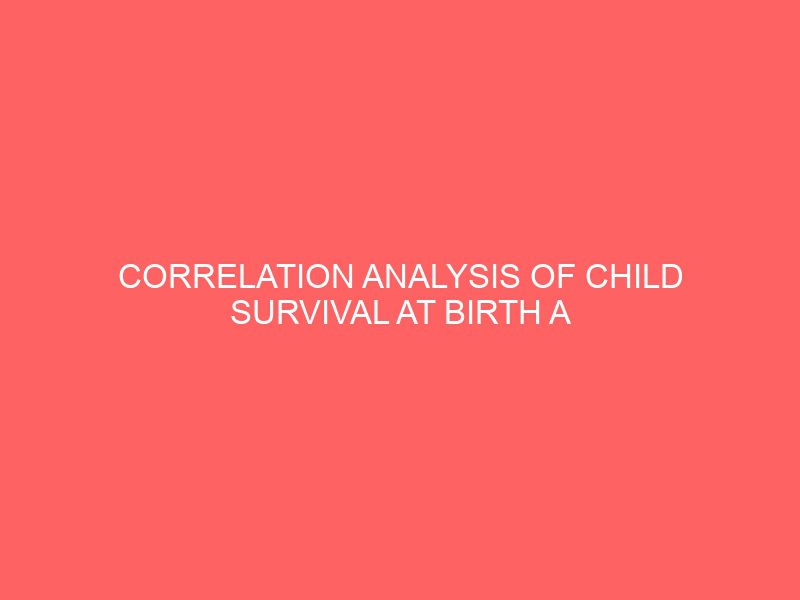CHAPTER ONE
1.0 Introduction
Giving birth is one of the most extraordinary experiences of a woman’s life. Yet after all the months of careful preparation and anticipation, the moment of birth is almost never what you had expected. But fortunately, despite what you may have thought when you were pregnant, these are not the issues that will make your child’s birth a success what count is the baby, here at last and healthy.
The child survival at birth will be determined right from the day one of the conception of the baby in the mother’s womb, the process of delivery, the expertise, the needed facilities available and the environment. That is child survival is primarily determined by the social and economic status of the child’s family essentially expressed by two indicators maternal education and some index of economic circumstances of the household Mosley, 1985. Various studies in Kenya have confirmed the significant relationship between socioeconomic factors and infant/child survival Muganzi, 1984; Odhiambo, 1991, Onuma 1991.
In the third World, it is a much riskier proposition: neonatal deaths rates in sub-Saharan Africa and South Asia are more than 3.7 and on average 1 in 48 women die during childbirth. The natural mortality rate of childbirth where nothing is done to avert maternal death has been estimated as being between, 1,000 and 1,500 deaths per 100,000 births.
The most important factors affecting mortality in childbirth are adequate nutrition and access to quality medical care access is affected both by the loss of available care, and distance from the health services. Medical care in this context does not refer specifically to treatment in hospital, but simply the presence of an attendant with midwifery skills. Factors that may make a birth high risk include prematurity, high blood pressure, diabetes and previous caesarean section.
One of the most dangerous risks to the fetus is that of premature birth and its associated low neonatal weight. The more premature or underweight a baby is the greater the risks for neonatal death and for pulmonary, respiratory, neurological or other sequelae. About 12 of all infants born in the United States are born prematurely. In the past 25 years, medical technology has greatly improved the chances of survival of premature infants in industrial nations. In the 1950s and 1960s, approximately half of all low-birth-weight babies in the US died. Today, more than 90 survive. The first hours of life for premises are critical, especially the very first hour of life. Rapid access to a Neonatal intensive care unit is of paramount importance.
Age limitation seems not to constitute impediment or barrier to pregnancy. In November 2004 Aleta. St. James, a 56-year-old single mother gave birth to twins conceived through in vitro fertilization. In 2005, a 67-year-old Romanian woman gave birth by caesarean to one surviving twin.
This research considers certain factors that predict survival of a new born baby. These factors include age of the mother, gestational period, baby’s weight, type of delivery and the Apgar score.
1.1 Aims and Objectives of the Study
The broad aim of this research work is to examine the factors that contribute to the survival of newborn babies in Osun state Hospital Asubiaro Osogbo.
The specific objectives are as following:
- To determine the general forms of the logistic and hazards models.
- To identify the factor that most determines Childs survival.
- To predict survival status of a child.
To know the contribution of the type of delivery to the survival of a child at birth.
1.2 Significance of the study
The reason for this study is to know the factors contributing to the survival of a New born baby.
This project work will also help to decrease the mortality rate among the children.
1.3 Scope and Limitation of the Study
The scope of this study is the Osun State Hospital Asubiaro Osogbo. The scope of the study should have been extended to various hospitals like the General Hospital Ede; LAUTECH Teaching hospitals and some other hospital to have a more accurate conclusion and recommendation but due to some limitation like:
Time Constraints: The time that was given for the submission of the project work is very short in various hospitals will:
- Money Constraint
- Confidentially
1.4 Definitions of Terms
BIRTH: This is the process by which individual creates more of their own kind.
BIRTH SPACING: This is the number of months or years between the previous birth and the current birth.
PARITY: This is the reproductive history of the mother.
APGAR SCORE: This is the first test giving to a child at one and five minutes respectively after birth to know the physician estimate of the baby’s general condition at birth.








Reviews
There are no reviews yet.